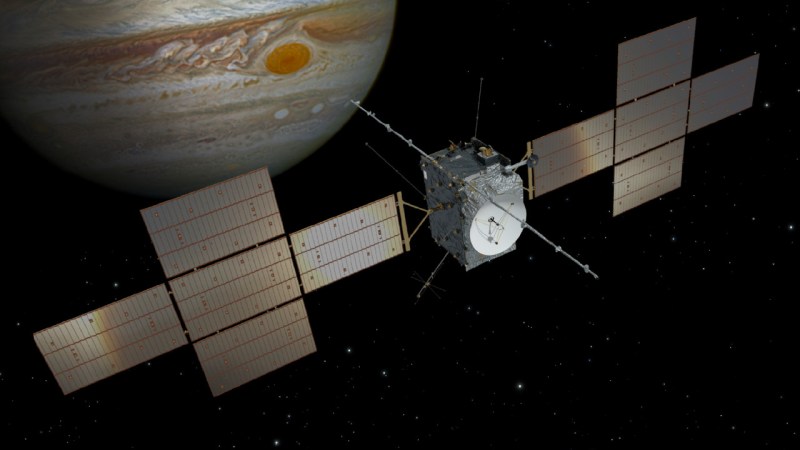After ESA’s Jupiter-bound space probe Juice (Jupiter Icy Moons Explorer) launched on April 14th of this year, it initially looked as if it had squeezed out a refreshingly uneventful deployment, until it attempted to unfurl its solar panels and antennae. One of these antennae, for the RIME (Radar for Icy Moons Exploration) instrument that uses ice-penetrating radar to get a subsurface look at Jupiter’s moons, ended up being rather stuck. Fortunately, on May 12th it was reported that ESA engineers managed to shock the sticky pin loose.

We previously covered the discovery of Juice’s RIME antenna troubles, with one of the retaining pins that hold the antenna in place in its furled position stubbornly refusing to shift the few millimeters that would have allowed for full deployment. Despite the high-tech nature of the Juice spacecraft, the optimal solution to make the pin move was simply to try and shake it loose.
Attempts were initially made using the spacecraft’s thrusters to shake the whole vehicle, as well as by warming it in sunlight. Each of these actions seemed to help a little bit, but the breakthrough came when a non-explosive actuator (NEA) was actuated in the jammed bracket. This almost fully fixed the problem, leading the team in charge to decide to fire another NEA, which finally allowed the pin to fully shift and the antenna to fully deploy and lock into place.
Assuming no further issues occur during Juice’s long trip through the Solar System, Juice is expected to arrive at Jupiter after four gravity assists in July of 2031. There it will perform multiple science missions until a planned deorbit on Ganymede by late 2035.
















…but Ganymede already had a population in large glasshouses where they were growing food for the belt. Then the protomolecule man came along, and other baddies then destroyed the in-orbit floating mirrors.
(Reference “The Expanse”)
Too bad this feature wasn’t present in one of the older space missions. It would have been The RIME of the Ancient Mariner.
HAD needs various “like-ons” .. would have happily cast a “funny” vote here
Why does someone else need to know what you think?
I mean, they were kind of asking for it, coming up with such a clever name for the instrument. They should have expected the antenna would freeze up.
If there was something you could actuate “in the jammed bracket”, why wasn’t that the first thing you would try, as opposed to it being a “breakthrough”.
I located a brief summary of the NEAs used on the Juice RIME antenna here: https://www.arquimea.com/case-studies/hdrm-juice-esa-mission/
While this isn’t an answer to your question, these are the keywords that will show up in any answer if one is to be found.
Maybe this could be called “convulsive maintenance” or “vibratory maintenance” or some other term for “shake it until it works again”
Percussive maintenance is the term you’re looking for.
My first foray into being a test engineer I got schooled on the term “percussive testing” which involved thumping the EUT with the butt-end of a screwdriver to see if anything stopped working.
Spacecraft with a vibrator, now that’s a golden record if I see one.
So looking at the article wkpad linked and some related sources like this one: https://www.arquimea.com/products/space-release-mechanisms-hdrm-react/ I think the actuator mentioned was not actually on the bracked but on some unrelated part. Operating it probably involves something of a shock/vibration to the rest of the satellite which triggered the release.
NEA 6, the actuator that released the antenna from the stuck pin was intended for the subsequent deployment stage. If you watch the video of the event and compare it with the animation of how it was supposed to deploy you’ll see the difference. It was not qualified to deploy like that, and as such, carries a certain amount of risk. This is why it was carried out only after attempting to dislodge it in such a way that it can continue to deploy nominally, using other means.
I’m actually really glad to hear this worked. That’s a big accomplishment for something like this, where the investment is STEEP, the application is remote in the extreme, and the available solutions are extremely thin. That’s problem-solving in the style that can only be found in space exploration: one does what they can with what’s available, and God help you if you can’t. So you do. A lot of valuable information will come back because of somebody’s extremely high-pressure kludge. Congratulations to them.
Probably could have programmed some part of it to pulse out “Shake it off’ to make it pop loose. Other possibilities would be “You shook me all night long” or “I want to break free”. Give it the Floppotron treatment.
Inquiring minds want to know: does the spacecraft have “JUICY” in large letters across its backside?
(not a fashion choice I would make)
All these years I’ve been building actuators, when I could have been calling them “Non Explosive” actuators. Which sounds cooler, even if it’s just a normal actuator.
Except a ‘normal’ actuator in these applications is a one-shot pyro device, so the distinction is meaningful.
Useful video explaining how NEA works:
https://piped.video/watch?v=nAIru9vHkWc
(Piped is a non-hateful interface to watch youtube videos.)
Remote repairs of spacecrafts in general, esp. electrical…
I’m wondering how are the design guides that allow this. I read about the power supply repair of voyager, they bypassed some voltage regulators, or Apollo problems which were solved by connecting bus bars to totally unplanned devices. I mean, is there something like a crossbar switch in the spacecraft that allows to connect anything with anything?
The space equivalent of turning it off and back on again?
I’m so happy to hear they were able to achieve deployment. Those poor engineers and scientists have been through the ringer.